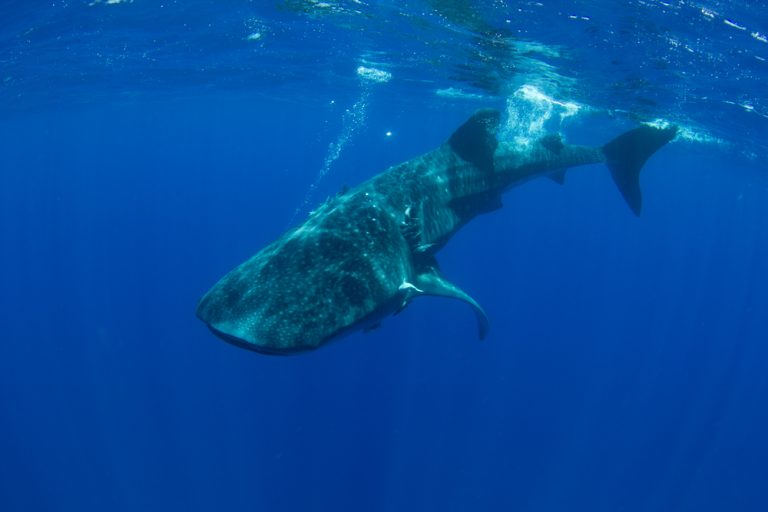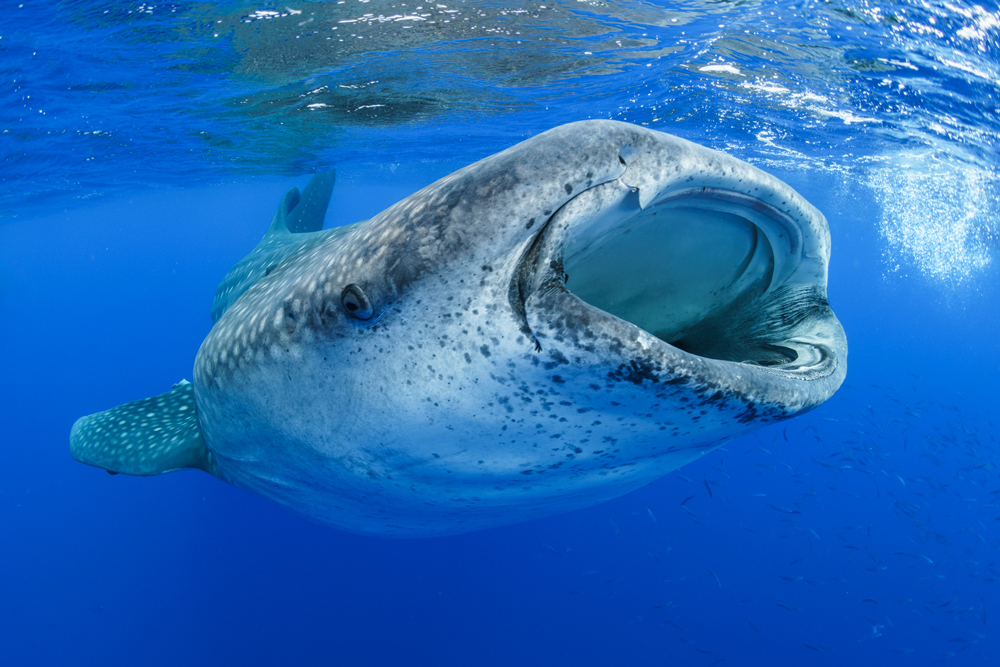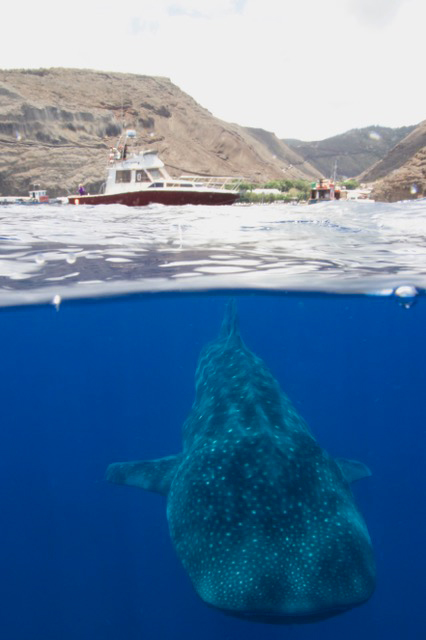The tiny volcanic island of St Helena could provide the key to whale shark reproduction. Sarah Kingdom went diving in this underwater world 1 800km west of Angola
With great excitement we tumbled into the water, masks askew and snorkels barely gripped in our mouths. We had come to St Helena at the tail end of the whale shark season, and after a morning spent looking for this most enticing of species, we had finally found one. As we entered the water and adjusted our snorkelling gear, we were face-to-face with an alarmingly large and wide-mouthed creature. Whale sharks have rows of up to 350 teeth. They also have 10 filter pads and feed on plankton, fish eggs and algae. Although the whale shark’s vestigial teeth may be so small you can see little more than their gums, and their gullets may only be the size of a fist, it was still quite disconcerting to be so close to one of these rare and extraordinary filter-feeding sharks.

Remora suckerfish hitches a ride. Photo: Environmental Management Division, St Helena
Around St Helena whale sharks are commonly referred to as bone sharks. They visit the area annually from November to April, peaking in January and February. An even split of adult males and females is unique to the St Helena population, whereas juvenile males tend to dominate in other locations. This 50/50 mix is incredibly important and scientists believe the island may play a vital role as a mating ground for whale sharks, behaviour that has never been recorded in the species.
Beth Taylor, head of marine conservation at the St Helena National Trust, says the unusual behaviour around St Helena presents a unique opportunity to study whale sharks. “St Helena also remains the only place in the world where two anecdotal reports have been submitted of people seeing mating behaviour,” she says.

A mouth this wide is rather intimidating. Photo: Simon J Pierce – www.simonjpierce.com
Researchers are yet to witness this. “We haven’t managed to catch them in the act during any of our expeditions to date, but it remains probably the most promising place in the world to document this important part of their life story. We still don’t know where they give birth either, it seems they like to keep
a few key parts of their lives secret,” says Dr Alistair Dove, vice president of research and conservation at Georgia Aquarium in Atlanta, USA.
The National Trust (in conjunction with the Blue Marine Foundation) and Georgia Aquarium have been undertaking whale shark monitoring, research and tagging programmes in the waters around St Helena for several years. In total, 175 whale shark encounters were recorded from over 70 hours spent on the water during the 2018/2019 breeding season. Blood samples were collected, ultrasound scans were performed, swabs were gathered, photographic identification methods were employed, and laser callipers were used to measure size.
Information gathered will help scientists understand whale sharks better, contribute vital information regarding health, reproductive and pregnancy status, and, importantly, help highlight areas of the ocean that potentially need more protection than others.

Deep water monitoring tag on a whale shark. Photo: Simon J Pierce – www.simonjpierce.com
In addition, tracking devices were attached to individuals, including a world first – the use of three ‘deep water monitoring’ tags that are designed to go as deep as six kilometres. Data collected will answer questions on how deep the whale sharks dive, as well as help monitor habitat use around St Helena island and the surrounding waters.
Very few wildlife encounters rank as high as your first whale shark sighting. Snorkelling is the best way to interact with these magnificent creatures as they are usually found near the surface in this area. While whale sharks are generally undeterred by swimmers, they can, at times, be quite curious about ‘strangers’ visiting their realm… this can be a little intimidating and we found ourselves frequently ‘back-pedalling’ in an attempt to maintain the required 3m buffer distance between us.
Whale shark research taking place at St Helena

St Helena is one of a handful of locations around the world where whale sharks gather in any number.
Georgia Aquarium conducted its first expedition to St Helena to study whale sharks in 2015 and
has returned three times since. Dr Dove heads up the team and explained the tagging process in more detail.
Animal telemetry or tagging allows scientists to follow animals and collect other data about how they experience the world. The land animal equivalent would include things like radio collars, but for marine animals it’s a bit more challenging. A few technological solutions have been developed to allow tracking of whale sharks as they go about their lives. “The tags are either inserted into the skin on a short tether, or clamped on the dorsal fin,” Dove explains. “They are designed to record data for a programmed period and then come off, float to the surface and relay their data via satellite.”
Whale sharks are particularly challenging because the species is capable of diving to more than two kilometres. “In fact, the whale shark is the deepest diving fish we know of, and that makes the tagging even harder, because the extreme pressures that occur at those depths can easily destroy an expensive satellite tag,” he adds. “We worked with engineers from iSea Solutions to develop a tag that could withstand the extreme depths to which the sharks dive.”
Dove says they do not have any data back yet, but they are excited to see what happens when the tags finish their mission later in the year and (hopefully) begin reporting their data payload via satellite.

